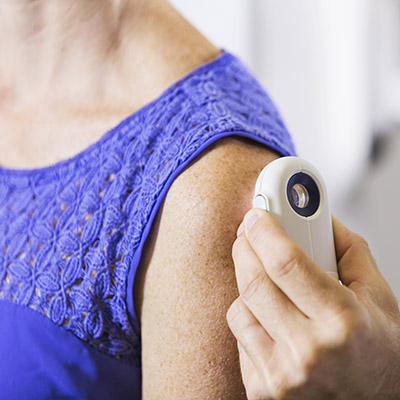Skin Cancer
 Most early thyroid cancers are found when patients see their doctors because of neck lumps or nodules they noticed. If you have unusual symptoms such as a lump or swelling in your neck, you should see your doctor right away. Some doctors also recommend that people examine their necks twice a year to look and feel for any growths or lumps.
Most early thyroid cancers are found when patients see their doctors because of neck lumps or nodules they noticed. If you have unusual symptoms such as a lump or swelling in your neck, you should see your doctor right away. Some doctors also recommend that people examine their necks twice a year to look and feel for any growths or lumps.
Diagnosis
Common tests used for diagnosing thyroid cancer include:
- Biopsy: Taking a sample of throat tissues or cells. There are two ways to conduct the biopsy:
- Fine needle aspiration (FNA): A very thin needle attached to a syringe is used to extract, or aspirate, cells from a lump or tumor
- Incisional biopsy: a small piece of tissue is cut from an abnormal-looking area
- Imaging tests: These can include X-rays, CT scans, MRI, nuclear medicine scan, PET scan or ultrasound
- Lab tests: These can involve advanced genomic testing, which analyzes the DNA alterations driving the cancer’s growth; nutrition panels, which identify certain deficiencies that can be boosted to support quality of life; and other procedures
- Laryngoscopy: The doctor uses a special scope to analyze vocal cords and other features before any surgery can be performed
People with a family history of medullary thyroid cancer (MTC) might have a very high risk for developing this cancer. Most doctors recommend genetic testing for these people when they are young to see if they carry the gene changes linked to MTC. For those who may be at risk but don’t get genetic testing, blood tests can help find MTC at an early stage, when it may still be curable.
After thyroid cancer is found, your doctor will discuss treatment options with you. It is a good idea to take time to think about each of them. In choosing a treatment plan, things to take into account include the type and stage of the cancer and your overall health.
Treatment options
- Surgery
- Radioactive iodine treatment
- Thyroid hormone treatment
- External beam radiation treatment
- Chemotherapy
- Targeted therapy
The best approach often uses two or more of these methods, and most patients are cured of their thyroid cancer in this way.
If a cure is not likely, the goal may be to remove or destroy as much of the cancer as possible and to prevent the tumor from growing, spreading, or coming back for as long as possible. Sometimes treatment is aimed at relieving symptoms (palliation), such as pain or problems with breathing and swallowing.
Make an Appointment
Find a location close to home and make an appointment today.
Other tests may include:
- Skin biopsy
- Shave (tangential) biopsy
- Punch biopsy
- Incisional and excisional biopsies
- “Optical” biopsies
- Lymph node biopsies
- Fine needle aspiration biopsy (used on lymph nodes)
- Sentinel lymph node biopsy
Imaging tests can also be done to help determine how well treatment is working or to look for possible signs of cancer coming back (recurring) after treatment.
- Chest X-ray
- Computed tomography (CT) scan
- CT-guided needle biopsy
- Magnetic resonance imaging (MRI) scan
- Positron emission tomography (PET) scan
- Blood tests
Treatment for skin cancers
Treatment for the various types of skin cancers vary widely, and your doctor can advise you about your options based on type. Treatments can include:
- Prescription creams
- Other medications
- Radiation
- Chemotherapy
- Surgery

